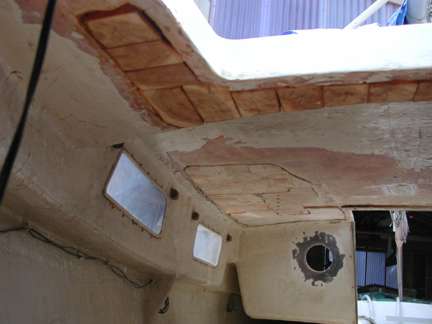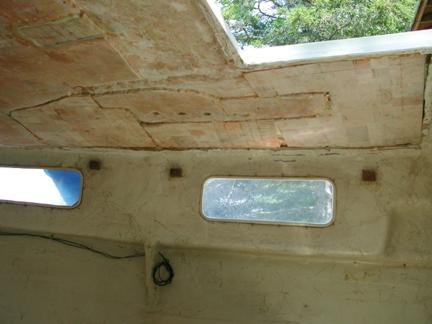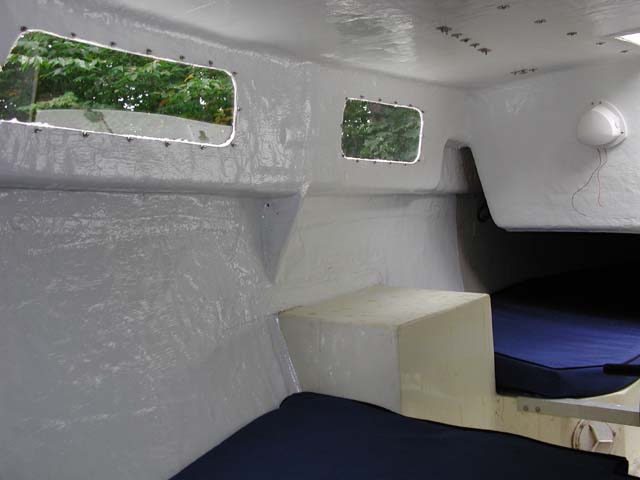Formica Laminates & epoxy
-
daysailor17
- Bottom Paint Application Technician
- Posts: 16
- Joined: Sat Oct 29, 2005 11:51 am
- Location: Green Bay, WI
Formica Laminates & epoxy
I have a 1970 Islander Bahama and have considered using a Formica laminate in the cabin to cover the inside of the hull. It is pretty bad with coats of nasty epoxy paint that I plan to hit with a grinder to take the paint off. I know a good sanding is required to take the shine off for a good base to adhere to, but all of the adhesives I read about is contact cement. Has anyone used such a laminate with epoxy and what was the result? I am thinking that the epoxy will seal the glass and the formica will cover all of the imperfections with a nice durable surface that is easily cleaned. I would like to do wooden slats like a wooden ceiling, but the surface area is huge and the cost of the materials will be significant. A nice neutral colored laminate would appear similar to a hull-liner, any thoughts? Its cheap, but sometimes cheap leads to much more problems then hard labor.
E
E
"I don't wanna grow up, I don't wanna be a man.....I wanna stay a kid as long as I can."
- Tim
- Shipwright Extraordinaire
- Posts: 5708
- Joined: Tue Apr 01, 2003 6:39 pm
- Boat Name: Glissando
- Boat Type: Pearson Triton
- Location: Whitefield, ME
- Contact:
Epoxy will work to secure the material, but how will you clamp and press the HP laminate (Formica) into position--especially on a curved surface--while the epoxy cures? The beauty of contact cement is that its bond is instantaneous. Traditional solvent-based contact cement is very strong, and should hold up fine in an interior marine application. I applied Formica to some bulkheads with regular contact cement, and it is holding up very well with no failures or loose spots.
I worry that the inside of any hull might be too unfair to allow for successful use of HP laminate. Any voids, large or small, will not only weaken the overall bond, but will be subject to damage from normal use. Overcoming these issues seems, to me, to make such a project infeasible; it makes more sense to use your labor towards other means of covering the inside of the hull--those that will ultimately be more attractive and satisfying too boot.
When I think of possible ways to increase one's level of frustration, installing sharp, brittle, ungainly pieces of HP laminate onto a curved, uneven surface has to be near the top of the list!
If, instead of a raw fiberglass surface, you have an interior liner, even if the paint is in poor condition at least you know that there is a smooth, fair surface beneath. I think it would make more sense to remove the paint and apply new paint, rather than try to cover anything with the HP laminate.
A wooden ceiling need not cost that much. You can use many inexpensive woods for this; it need not be a tropical hardwood. Obviously, you have to like the appearance of whatever wood you choose, but even a white pine ceiling, when installed on battens away from a possibly sweating hull, would last for a long time. And the strips are narrow and thin, so one can get many pieces out of a relatively small amount of wood.
To do the ceiling pictured below, I used about 4 cypress boards, each 1" thick by 4"wide and 8' long--hardly a lot of material by any standard. I cut the boards into 1" wide strips about 3/16" in thickness. This is something to keep in mind. Cypress happens to be quite inexpensive. Now, maybe you don't want the look of cypress, but the point is that there are other good wood choices for a project like a ceiling--and the wood need not be of #1 clear/select quality either.
Cedar, pine, fir, cypress, ash, mahogany...these are some of a short list of potential inexpensive materials. I have even seen many ceilings made from closely-placed strips of luaun plywood. Personally I hate this, but it illustrates the wide variety of potential materials.

I worry that the inside of any hull might be too unfair to allow for successful use of HP laminate. Any voids, large or small, will not only weaken the overall bond, but will be subject to damage from normal use. Overcoming these issues seems, to me, to make such a project infeasible; it makes more sense to use your labor towards other means of covering the inside of the hull--those that will ultimately be more attractive and satisfying too boot.
When I think of possible ways to increase one's level of frustration, installing sharp, brittle, ungainly pieces of HP laminate onto a curved, uneven surface has to be near the top of the list!
If, instead of a raw fiberglass surface, you have an interior liner, even if the paint is in poor condition at least you know that there is a smooth, fair surface beneath. I think it would make more sense to remove the paint and apply new paint, rather than try to cover anything with the HP laminate.
A wooden ceiling need not cost that much. You can use many inexpensive woods for this; it need not be a tropical hardwood. Obviously, you have to like the appearance of whatever wood you choose, but even a white pine ceiling, when installed on battens away from a possibly sweating hull, would last for a long time. And the strips are narrow and thin, so one can get many pieces out of a relatively small amount of wood.
To do the ceiling pictured below, I used about 4 cypress boards, each 1" thick by 4"wide and 8' long--hardly a lot of material by any standard. I cut the boards into 1" wide strips about 3/16" in thickness. This is something to keep in mind. Cypress happens to be quite inexpensive. Now, maybe you don't want the look of cypress, but the point is that there are other good wood choices for a project like a ceiling--and the wood need not be of #1 clear/select quality either.
Cedar, pine, fir, cypress, ash, mahogany...these are some of a short list of potential inexpensive materials. I have even seen many ceilings made from closely-placed strips of luaun plywood. Personally I hate this, but it illustrates the wide variety of potential materials.

---------------------------------------------------
Forum Founder--No Longer Participating
Forum Founder--No Longer Participating
-
CharlieJ
- Wood Whisperer
- Posts: 649
- Joined: Fri Aug 19, 2005 7:42 pm
- Location: South coast of Texas, Matagorda Bay
Agree totally with Tim.
Here's a shot of our Meridian 25 forecabin with ash ceiling. Time consuming to be sure, but not all that expensive. I ripped the 3/4 ash into 1 1/2 inch strips, then resawed to 3/8 and planed, so they are slightly over 1/4. After that, my wife did the varnishing and all the installation.

Here's a shot of our Meridian 25 forecabin with ash ceiling. Time consuming to be sure, but not all that expensive. I ripped the 3/4 ash into 1 1/2 inch strips, then resawed to 3/8 and planed, so they are slightly over 1/4. After that, my wife did the varnishing and all the installation.

-
Jason K
- Boat Obsession Medal Finalist
- Posts: 741
- Joined: Fri Mar 18, 2005 10:41 pm
- Boat Name: Rambunctious
- Boat Type: J/30
- Location: Mandeville, LA
- Contact:
I am enthusiastic about saving a dollar here and there when its possible. However, I can't recommend it when depreciates the aesthetic value of the boat. Its hard for me to see how that project would be something you would be happy with when you finished. Plus, if you don't like it, you've got a huge amount of plastic either cemented or epoxied to the inside of your boat. Not fun.Its cheap, but sometimes cheap leads to much more problems then hard labor.
However, I like the goal you are trying to achieve. The interior of my boat will need some work to make the inside of the hull and cabin top look much better. I have no liner and I'll probably start off by fairing the bad spots and painting carefully. Have you considered simply painting? It's very cheap and, if you don't like it, it's easy to try something else. You could even isolate your first efforts to the V-berth to see how you like it.
- catamount
- Candidate for Boat-Obsession Medal
- Posts: 378
- Joined: Sun Jun 19, 2005 7:30 am
- Boat Name: GREYHAWK
- Boat Type: Peterson 34
- Location: Boothbay Harbor, ME
- Contact:
Paint
I concur with the recommendation to try a fresh coat of paint first.
Here are some shots of the interior of my San Juan 21 QUASAR before:


and after:

I painted with Petit EasyPoxy White.
Regards,
Here are some shots of the interior of my San Juan 21 QUASAR before:


and after:

I painted with Petit EasyPoxy White.
Regards,
Last edited by catamount on Fri May 01, 2009 11:31 am, edited 1 time in total.
Tim Allen -- 1980 Peterson 34 GREYHAWK
Harborfields Housekeeping Cottages, West Boothbay Harbor, Maine
Sailors for the Sea, a new voice for ocean conservation
Harborfields Housekeeping Cottages, West Boothbay Harbor, Maine
Sailors for the Sea, a new voice for ocean conservation
-
Summersdawn
- Skilled Systems Installer
- Posts: 279
- Joined: Fri Nov 04, 2005 6:34 pm
I think you will find slats of wood to be pretty similar in price to sheets of Formica, provided you don't get carried away with exotic hardwoods. I would probably go with red cedar slats finished bright. That being said, there is alot of red cedar where I live, and prices may be alot more reasonable here.
Rick
Summer's Dawn
24 San Juan #380
Summer's Dawn
24 San Juan #380
-
daysailor17
- Bottom Paint Application Technician
- Posts: 16
- Joined: Sat Oct 29, 2005 11:51 am
- Location: Green Bay, WI
Very excellent points
THank you all for very good tips. Oh lord, I was being quite numb as I began to think of trying to bend formica to the shape of the hull while holding it until the epoxy dried! That is why this site helps me, it keeps me from TRYING numb things.
I like the way the v-berth in the pics turned out, I have quite a bit of area, basically the whole inside of the hull from bow to stern. I suppose I could do it all. How much space did you leave between the staves in order to allow ventilation?
Is red cedar the stuff that smells SOOOO good and keeps the moths away as well?
The gent that had the boat before has accomplished a paint job in the main cabin with a 2-part epoxy paint in which he has about 2 gallons left he said I could have with the boat. By a read of the can, it is damn toxic, a complete pain to work with due to environmental conditions needing to be just right. I am not liking the look of what he did and he spent a huge amount of time. I used to have time not money, now I have a little money and no time. That is why i took the boat, so I can be out of cell phone range, too far away by car, and weather is limiting return to port!
Thanks guys E
I like the way the v-berth in the pics turned out, I have quite a bit of area, basically the whole inside of the hull from bow to stern. I suppose I could do it all. How much space did you leave between the staves in order to allow ventilation?
Is red cedar the stuff that smells SOOOO good and keeps the moths away as well?
The gent that had the boat before has accomplished a paint job in the main cabin with a 2-part epoxy paint in which he has about 2 gallons left he said I could have with the boat. By a read of the can, it is damn toxic, a complete pain to work with due to environmental conditions needing to be just right. I am not liking the look of what he did and he spent a huge amount of time. I used to have time not money, now I have a little money and no time. That is why i took the boat, so I can be out of cell phone range, too far away by car, and weather is limiting return to port!
Thanks guys E
"I don't wanna grow up, I don't wanna be a man.....I wanna stay a kid as long as I can."
-
CharlieJ
- Wood Whisperer
- Posts: 649
- Joined: Fri Aug 19, 2005 7:42 pm
- Location: South coast of Texas, Matagorda Bay
Western Red Cedar has almost no smell. The cedar that does smell is aromatic cedar. Usually not found in really long lengths and has a BUNCH of knots in it ( normally).
Strangely enough, here close to where mucho cedar is cut, I can't get aromatic cedar in board form- last time I had to repair a cedar chest I bought a fence post and cut my boards from that.
I can however, go buy long length WRC boards, which come from the west coast. Go figure.
Strangely enough, here close to where mucho cedar is cut, I can't get aromatic cedar in board form- last time I had to repair a cedar chest I bought a fence post and cut my boards from that.
I can however, go buy long length WRC boards, which come from the west coast. Go figure.
-
Summersdawn
- Skilled Systems Installer
- Posts: 279
- Joined: Fri Nov 04, 2005 6:34 pm
Western red cedar has a slight smell, however, if you put a finish on it (or aromatic cedar for that matter), you've effectivly covered the smell. The reason I like to use red cedar is it is not particularily expensive, easy to work, resistant to rot, and comes in some great colors. It can be very ligh colored, or quite red and rich. If you choose the red color, and finish it with varnish, Cetol or varathane, it has a very similar color to teak.
Since cedar is pretty soft, to get a smooth finish the cedar has to be sanded with a fine grit sandpaper first.
Since cedar is pretty soft, to get a smooth finish the cedar has to be sanded with a fine grit sandpaper first.
Rick
Summer's Dawn
24 San Juan #380
Summer's Dawn
24 San Juan #380
-
heartofgold
- Skilled Systems Installer
- Posts: 237
- Joined: Wed Mar 17, 2004 10:47 am
- Location: Pensacola Bay
- Contact:
I completed my hull ceiling from cherry. I ripped a single 6/4 board into 1/4" slats and used two 7"x8' boards. Total cost (lumber) $90.

For the headliner, I used 2 sheets of beadboard, which I painted with with EasyPoxy. I purchased 2 sheets from Lowes (none of my local wholesalers carried it any cheaper) for $35 each.

The photo here shows the roughly fit installation. It still has to be mounted securely and trimmed with cherry.
For the headliner, I used 2 sheets of beadboard, which I painted with with EasyPoxy. I purchased 2 sheets from Lowes (none of my local wholesalers carried it any cheaper) for $35 each.
The photo here shows the roughly fit installation. It still has to be mounted securely and trimmed with cherry.
Doug
http://heartofgoldsails.com
"The cure for anything is salt water: sweat, tears or the sea."
Karen Blixen
http://heartofgoldsails.com
"The cure for anything is salt water: sweat, tears or the sea."
Karen Blixen